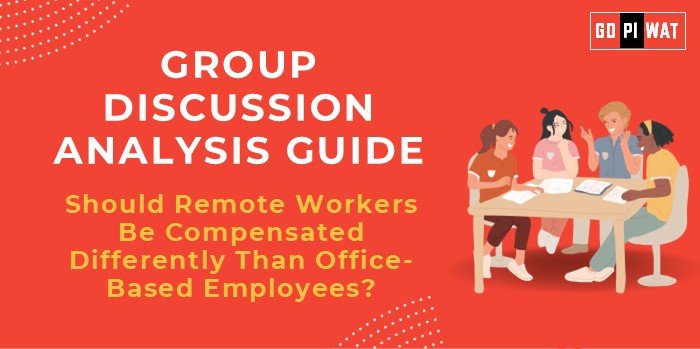📋 Group Discussion (GD) Analysis Guide: Should Remote Workers Be Compensated Differently Than Office-Based Employees?
🌟 Introduction to the Topic
Opening Context: The global rise of remote work, fueled by advancements in technology and accelerated by the COVID-19 pandemic, has sparked debates about fair compensation structures for remote and office-based employees.
Topic Background: The concept of differentiated compensation stems from variations in costs associated with commuting, geographic living standards, and office infrastructure usage. Companies like Google and Facebook have adopted location-based pay models, while others maintain equal pay policies.
📊 Quick Facts and Key Statistics
- 🌍 Remote Work Growth: 74% of professionals expect remote work to become standard globally (LinkedIn, 2024).
- 💰 Cost Savings: Businesses save approximately $11,000 per remote worker annually due to reduced overheads (Global Workplace Analytics, 2024).
- 📈 Productivity Metrics: Remote employees report a 13% increase in productivity compared to in-office workers (Stanford Research, 2023).
- 📊 Living Wage Variability: Living costs can vary by up to 50% between urban and rural areas in the same country (OECD, 2024).
🤝 Stakeholders and Their Roles
- 🏢 Employers: Establish compensation models balancing equity, cost-efficiency, and talent attraction.
- 👥 Employees: Advocate for fair compensation reflective of work contributions, irrespective of location.
- 🏛️ Governments and Labor Unions: Frame regulations to ensure equitable labor practices and address disparities.
- 💻 Technology Providers: Enable effective remote work setups through innovative tools and platforms.
🏆 Achievements and Challenges
✨ Achievements:
- ✅ Business Savings: Companies save on office space and utilities, redirecting resources toward other business priorities.
- 🌍 Talent Acquisition: Broader hiring across geographies enables access to diverse skill sets.
- 😊 Employee Satisfaction: Remote flexibility enhances work-life balance, reducing attrition rates.
⚠️ Challenges:
- ⚖️ Equity Concerns: Pay differentiation may breed dissatisfaction among workers.
- 📊 Performance Measurement: Gauging output for remote roles is often ambiguous.
- 🗣️ Cultural Divide: Remote work risks diluting company culture and collaboration.
🌍 Global Comparisons:
- 🇺🇸 USA: Location-based pay policies are widely adopted, particularly in tech sectors.
- 🇮🇳 India: Equal pay models dominate, though remote work options are concentrated in IT services.
📄 Structured Arguments for Discussion
- 🟢 Supporting Stance: “Differentiated compensation reflects market realities, ensuring businesses stay competitive while managing costs effectively.”
- 🔴 Opposing Stance: “Equal pay aligns with the principle of equity, valuing skills and output over geographic location.”
- ⚖️ Balanced Perspective: “While compensation may vary by geography, employers must ensure transparency and fairness to prevent morale issues.”
🚀 Effective Discussion Approaches
🔑 Opening Approaches:
- 📊 Contrast: “Remote work enhances flexibility, but does it justify differentiated pay for the same job title?”
- 📈 Statistical Opening: “With productivity up by 13%, remote employees could argue they deserve higher compensation.”
🤔 Counter-Argument Handling:
- ⚖️ Rebuttal to Location-Based Pay: “Living costs do vary, but skills and performance should determine wages, not geography.”
- 🌟 Rebuttal to Equal Pay: “Cost-of-living adjustments are standard practices in global organizations to reflect regional disparities.”
📈 Strategic Analysis of Strengths and Weaknesses
- 💪 Strengths: Cost efficiency for businesses, flexibility for employees, expanded hiring pools.
- ⚠️ Weaknesses: Potential inequities, collaboration hurdles, administrative complexities.
- 💡 Opportunities: Innovative compensation models, better remote tools, global talent access.
- 🚧 Threats: Legal challenges, employee dissatisfaction, cultural erosion.
📚 Connecting with B-School Applications
- 🌟 Real-World Applications: Policy creation for equitable pay; cost-benefit analysis in operations.
- ❓ Sample Questions:
- 🗣️ “How can companies balance pay equity and operational efficiency?”
- 🤔 “Discuss a scenario where differentiated pay models might cause conflict.”
- 💡 Insights for B-School Students: Explore compensation structures in HR strategy, analyze cost-saving impacts, evaluate global talent management trends.


